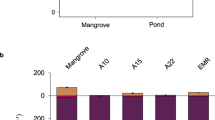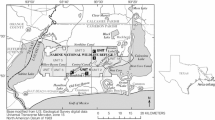Abstract
Oil sands exploration activities across the Alberta boreal peatlands requires tree clearing and results in sites being left compressed and with altered understory vegetation. Restoration techniques, including planting trees, mechanical mounding with tree planting, and spreading coarse woody debris have been tested across abandoned oil sands exploration sites. In this study two oil sands exploration sites were monitored 6- and 9-years post-treatment, along with two control areas disturbed 20 years ago with no active restoration treatment. Results were compared to a natural reference site to understand how various restoration techniques influenced carbon flux and growing season carbon balance. Tree ingress was observed across all parts of the restored oil sands exploration sites except a wet control area disturbed 20 years ago. The creation of dry microsites through the mechanical mounding technique substantially increased tree productivity, and we found that 9 years post-restoration the mounded area of an oil sands exploration site had a tree net primary productivity similar to the natural site. This carbon uptake, however, was partially offset by large emissions of methane from pools adjacent to mounds. We found that planting trees only could result in a growing season carbon balance that is within the range of a natural peatland 9 years following restoration. However, our estimates indicate that the mounding treatment 9 years following restoration released less carbon to the atmosphere overall compared to all other restoration treatments and control areas. This restoration technique may be useful if the restoration goal is focused on returning the carbon storage function at disturbed sites. As well as understanding attainability of restoration goals, evaluating ecohydrologic conditions of oil sands exploration sites pre-restoration is critical for informing the most appropriate restoration technique.



Similar content being viewed by others
Availability of data and materials
The datasets generated during and/or analysed during the current study are available in the University of Waterloo Dataverse repository. https://doi.org/10.5683/SP2/S6QE8E.
Code availability
The statistical program R 3.6.1 (R Core Team 2019) was used for inferential statistics. The code is available from the corresponding author by request.
References
Adkinson AC, Syed KH, Flanagan LB (2011) Contrasting responses of growing season ecosystem CO2 exchange to variation in temperature and water table depth in two peatlands in northern Alberta, Canada. J Geophys Res. https://doi.org/10.1029/2010JG001512
Alberta Energy Regulator (2019) In situ recovery. https://www.aer.ca/providing-information/by-topic/oil-sands/in-situ-recovery. Accessed 28 Apr 2019
Alm J, Shurpali NJ, Tuittila E-S, Laurila T, Maljanen M, Saarnio S, Minkkinen K (2007) Methods for determining emission factors for the use of peat and peatlands-flux measurement and modeling. Boreal Environ Res 12:85–100
Amlin NA, Rood SB (2001) Inundation tolerances of riparian willows and cottonwoods. J Am Water Resour As 37:1709–1720
Anthony C (1986) Bacterial oxidation of methane and methanol. Adv Microbiol Physiol 27:113–210
Bubier JL, Bhatia G, Moore TR, Roulet NT, Lafleur PM (2003) Spatial and temporal variability in growing-season net ecosystem carbon dioxide exchange at a large peatland in Ontario, Canada. Ecosystems. https://doi.org/10.1007/s10021-003-0125-0
Campbell C, Vitt DH, Halsey LA, Campbell ID, Thormann MN, Bayley SE (2000) Net primary production and standing biomass in northern continental peatlands, Information Report NOR-X-369. Edmonton, Canada
Caners RT, Lieffers VJ (2014) Divergent pathways of successional recovery for in situ oil sands exploration drilling pads on wooded moderate-rich fens in Alberta, Canada. Restor Ecol 22:657–667
Couwenberg J, Fritz C (2012) Towards developing IPCC methane ‘emission factors’ for peatlands (organic soils). Mires Peat 10(3):1–17
Davidson SJ, Goud EM, Franklin C, Nielsen SE, Strack M (2020) Seismic line disturbance alters soil physical and chemical properties across boreal forest and peatland soils. Front Earth Sci 8:281
Fenner N, Freeman C (2020) Woody litter protects peat carbon stocks during drought. Nat Clim Change 10(4):363–369
Filicetti AT, Cody M, Nielsen SE (2019) Caribou conservation: restoring trees on seismic lines in Alberta, Canada. Forests. https://doi.org/10.3390/f10020185
Government of Alberta (2017) DRAFT provincial woodland caribou range plan. Government of Alberta, Edmonton
Government of Canada (2019) Canadian climate normals 1981–2010 station data. http://climate.weather.gc.ca/climate_normals/results_1981_2010_e.html?stnID=2832&autofwd=1. Accessed 29 Apr 2019
Grigal DF, Kernik LK (1984) Generality of black spruce biomass estimation equations. Can J For Res 14:468–470
IPCC (2013) Climate change 2013: the physical science basis. In: Stocker, TF, Qin D, Plattner GK, Tignor M, Allen SK, Boschung J, Nauels A, Xia Y, Bex V, Midgley PM (eds) Contribution of Working Group I to the fifth assessment report of the intergovernmental panel on climate change. Cambridge University Press, Cambridge, United Kingdom and New York, United States of America, p 714
Janssen PHM, Heuberger PSC (1995) Calibration of process-orientated model. Ecol Modell. https://doi.org/10.1016/0304-3800(95)00084-9
Järveoja J, Nilsson MB, Crill PM, Peichl M (2020) Bimodal diel pattern in peatland ecosystem respiration rebuts uniform temperature response. Nat Commun 11(1):1–9
Lai DYF (2009) Methane dynamics in northern peatlands: a review. Pedosphere 19:409–421
Latham ADM, Latham MC, McCutchen NA, Boutin S (2011) Invading white-tailed deer change wolf-caribou dynamics in northeastern Alberta. J Wildl Manag 75:204–212
Lavigne MB (1982) Tree biomass equations for common species of Newfoundland, Information Report N-X-213. Newfoundland, Canada
Le Mer J, Roger P (2001) Production, oxidation, emission and consumption of methane by soils: a review. Eur J Soil Biol 37:25–50
Lee P, Boutin S (2006) Persistence and developmental transition of wide seismic lines in the western Boreal Plains of Canada. J Environ Manag 78:240–250
Lemmer M, Rochefort L, Strack M (2020) Greenhouse gas emissions dynamics in restored fens after in-situ well pad disturbances in the Alberta oil sands region. Front Earth Sci. https://doi.org/10.3389/feart.2020.557943
Li Z, Kurz WA, Apps MJ, Beukema SJ (2003) Belowground biomass dynamics in the Carbon Budget Model of the Canadian Forest sector: recent improvements and implications for the estimation of NPP and NEP. Can J For Res 33:126–136
Limpens J, Berendse F, Blodau C, Canadell JG, Freeman C, Holden J, Roulet N, Rydin H, Schaepman-Strub G (2008) Peatlands and the carbon cycle: from local processes to global implications—a synthesis. Biogeosciences 5:1475–1491
Lousier JD, Parkinson D (1976) Litter decomposition in a cool temperate deciduous forest. Can J Bot 54:419–436
Maljanen M, Sigurdsson BD, Guomundsson J, Oskarsson H, Huttunen JT, Martikainen PJ (2010) Greenhouse gas balances of managed peatlands in the Nordic countries—present knowledge and gaps. Biogeosciences 7:2711–2738
Moore TR, Knowles R (1989) The influence of water table levels on methane and carbon dioxide emissions from peatland soils. Can J Soil Sci 69:33–38
Munir TM, Xu B, Perkins M, Strack M (2014) Responses of carbon dioxide flux and plant biomass to water table drawdown in a treed peatland in Northern Alberta: a climate change perspective. Biogeosciences 11:807–820
Munir TM, Perkins M, Kaing E, Strack M (2015) Carbon dioxide flux and net primary production of a boreal treed bog: responses to warming and water-table-lowering simulations of climate change. Biogeosciences 12:1091–1111
Murray KR, Borkenhagen AK, Cooper DJ, Strack M (2017) Growing season carbon gas exchange from peatlands used as a source of vegetation donor material for restoration. Wetl Ecol Manag 25(4):501–515
Natural Regions Committee (2006) Natural regions and subregions of Alberta. Natural Regions Committee, Edmonton
Payette S, Deshaye J, Gilbert H (1982) Tree seed populations at the treeline in Rivière aux Feuilles area, northern Quebec, Canada. Arct Alp Res 14:215–221
Peterson EB, Peterson NM (1992) Ecology, management, and use of aspen and balsam poplar in the Prairie provinces. Edmonton, Canada
Pinheiro J, Bates D, DebRoy S, Sarkar D (2016) Linear and nonlinear mixed effects models, R package version 3.1–128. http://CRAN.R-project.org/package=nlme
R Core Team (2019) R: a language and environment for statistical computing. R Foundation for Statistical Computing. http://www.R-project.org/
Reichstein M, Tenhunen JD, Roupsar O, Ourcival J-M, Rambal S, Dore S, Valentini R (2002) Ecosystem respiration in two Mediterranean evergreen Holm Oak forests: drought effects and decomposition dynamics. Funct Ecol. https://doi.org/10.1046/j.0269-8463.2001.00597.x
Schreader CP, Rouse WR, Griffis TJ (1998) Carbon dioxide fluxes in a northern fen during a hot, dry summer. Glob Biogeochem Cycles 12:729–740
Sjörs H (1950) On the relationship between vegetation and electrolytes in northern Swedish mire water. Oikos 2:241–258
Strack M, Waddington JM, Turetsky M, Roulet NT, Byrne KA (2008) Northern peatland, greenhouse gas exchange and climate change. In: Strack M (ed) Peatlands and climate change. Saarijärven Offset Oy, Saarijärvi, pp 40–65
Strack M, Keith AM, Xu B (2014) Growing season carbon dioxide and methane exchange at a restored peatland on the Western Boreal Plain. Ecol Eng 64:231–239
Strack M, Softa D, Bird M, Xu B (2017) Impact of winter roads on boreal peatland carbon exchange. Glob Change Biol. https://doi.org/10.1111/gcb.13844
Szumigalski AR, Bayley SE (1996) Net above-ground primary production along a bog-rich fen gradient in central Alberta, Canada. Wetlands 16:467–476
Tuittila ES, Komulainen VM, Vasander H, Laine J (1999) Restored cut-away peatland as a sink for atmospheric CO2. Oecologia 120:563–574
Van Rensen CK, Nielsen SE, White B, Vinge T, Lieffers VJ (2015) Natural regeneration of forest vegetation on legacy seismic lines in boreal habitats in Alberta’s oil sands region. Biol Conserv 184:127–135
Viereck LA, Dyrness CT, Cleve KV, Foote MJ (1983) Vegetation, soils, and forest productivity in selected forest types in interior Alaska. Can J For Res 13:703–720
Vinge T, Lieffers V (2013) Evaluation of forest reclamation efforts on linear corridors of the Little Smokey. Unpublished report. https://www.evergreeninnovation.ca/wp-content/uploads/2017/11/Linear-Corridors-Report3.pdf. Accessed 28 Apr 2019
Vinge T, Pyper M (2013) A visual guide to handling woody materials for forested land reclamation. Edmonton, Canada
Vitt D, Bhatti J (2012) Restoration and reclamation of boreal ecosystems: attaining sustainable development. Cambridge University Press, Cambridge
Vitt DH, Halsey LA, Thormann MN (1997) The wetlands of Alberta: a 1:1,000,000 summary map, 2nd edn. Alberta Environmental Protection Agency, Edmonton
Vitt DH, Wieder RK, Xu B, Kaskie M, Koropchak S (2011) Peatland establishment on mineral soils: effects of water level, amendments, and species after two growing seasons. Ecol Eng 37(2):354–363
Vogel JG, Valentine DW, Ruess RW (2005) Soil and root respiration in mature Alaskan black spruce forests that vary in soil organic matter decomposition rates. Can J For Res 35:161–174
Waddington JM, Rochefort L, Campeau S (2003) Sphagnum production and decomposition in a restored cutover peatland. Wetlands Ecol Manag 11:85–95
Ward SE, Ostel NJ, Oakley S, Quirk H, Henrys PA, Bardgett RD (2013) Warming effects of greenhouse gas fluxes in peatlands are modulated by vegetation composition. Ecol Lett 16:1285–1293
Acknowledgements
Cenovus Energy provided funding for this project, site access, and established the restoration treatments and study plot design. Natural Sciences and Engineering Research Council of Canada (NSERC) provided funding for this project through NSERC Industrial Research Chair for Colleges grant to BX. The authors would like to thank Geoff Sherman, Melissa Kucey, Daniel Monaco, Brittany Whiteman, Frankie NcCorchuk, Sarah Ashe, Jorden Hayes, and Spencer Thome for their help in the field and laboratory. Comments from two anonymous reviewers greatly improved the manuscript, and we thank Barbara Murray for final proofreading.
Funding
Cenovus Energy provided funding for this project, site access, and established the restoration treatments and study plot design. Natural Sciences and Engineering Research Council of Canada (NSERC) provided funding for this project through NSERC Industrial Research Chair for Colleges grant to BX.
Author information
Authors and Affiliations
Corresponding author
Ethics declarations
Conflict of interest
This project was partially funded by Cenovus Energy. Michael Cody is employed by Cenovus Energy.
Additional information
Publisher's Note
Springer Nature remains neutral with regard to jurisdictional claims in published maps and institutional affiliations.
Supplementary Information
Below is the link to the electronic supplementary material.
Rights and permissions
About this article
Cite this article
Murray, K.R., Bird, M., Strack, M. et al. Restoration approach influences carbon exchange at in-situ oil sands exploration sites in east-central Alberta. Wetlands Ecol Manage 29, 281–299 (2021). https://doi.org/10.1007/s11273-021-09784-x
Received:
Accepted:
Published:
Issue Date:
DOI: https://doi.org/10.1007/s11273-021-09784-x




